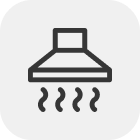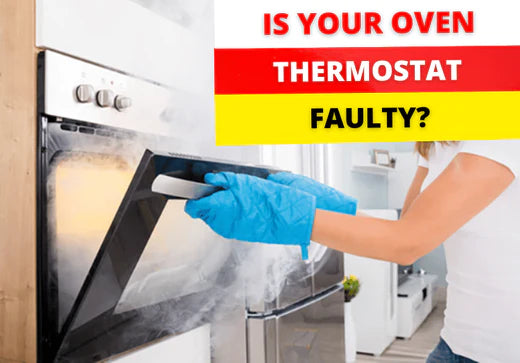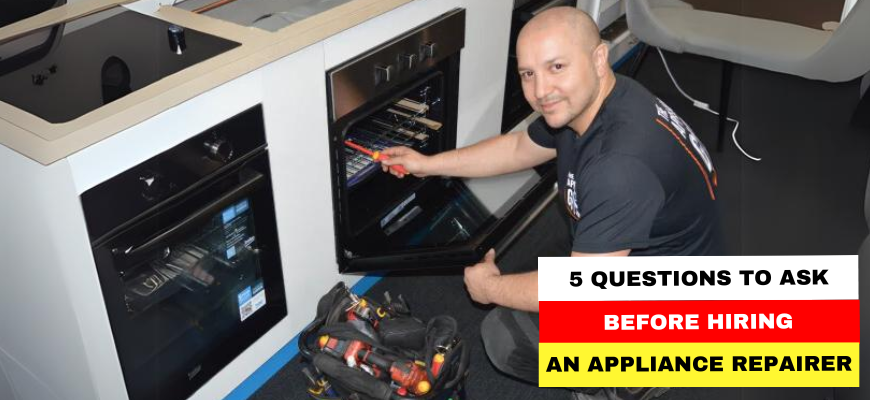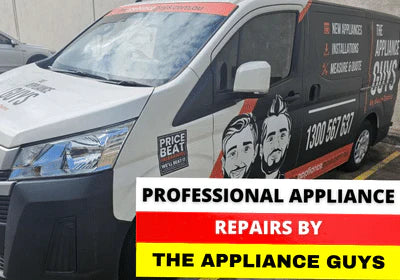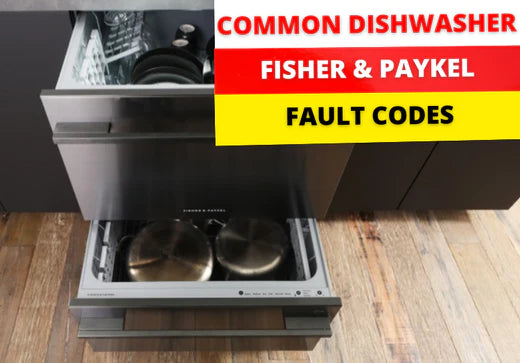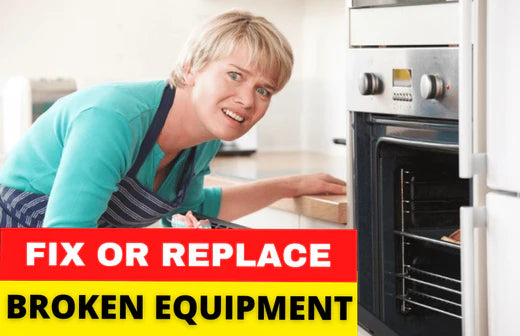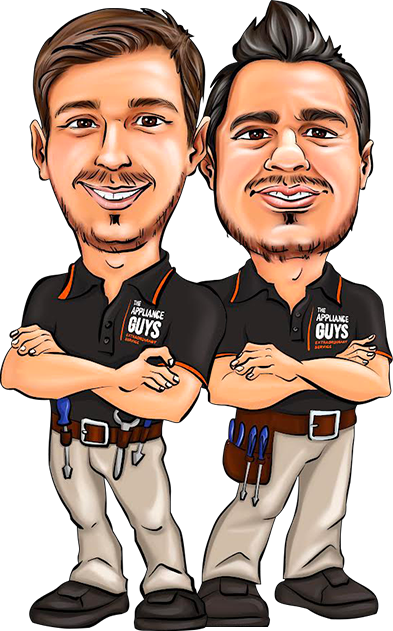Is your oven thermostat faulty?
If you notice that your food is burned or undercooked after correctly setting the temperature, your thermostat may be defective. That's right, it could be the thermostat rather than your cooking abilities. We have listed some common faults which could indicate that you have a faulty oven thermostat.
Temperature Fluctuation: You struggle to maintain a stable temperature, and the temperature may fluctuate or fail to equal the set temperature. As a result, cooking and baking results are variable at best.
Overheating: You set your the oven to a moderate temperature only for the oven to end up getting too hot almost causing a fire and damage to your food.
Underheating: You set your oven to a high temperature only to find that the oven can not become hot enough no matter how long you leave it to heat.
Slow Pre-Heating: Your oven takes longer than usual to reach the right temperature.
No heat - Your oven isn't producing any heat, it could be due to a broken thermostat and can also be caused by other problems, such as a faulty heating element.
Temperature Extremes - Your oven temperature abruptly and unexpectedly increases or dips causing inconsistent cooking and baking.
What is an oven thermostat?
An oven thermostat is found in both electric and gas ovens and is an important part of an oven since it controls the temperature in the oven. It works by monitoring the temperature of the air within the oven chamber and then switching the heating elements or gas burner on and off to maintain the desired temperature.
How do oven thermostats work?
Ok, here comes a bit of the geeky stuff. Previously, bimetal thermostats were utilized on appliances such as ovens; however, nowadays, the majority of thermostats found in your standard residential ovens are what we term capillary tube thermostats. Capillary tube thermostats are simple in operation, as they use switch contacts which are linked linked to a flexible metal bellows with a small tube called a capillary tube. The length of the tube is determined by the purpose for which it will be used. This tube is typically filled with a chemical like Freon gas with one end of the tube is crimped and sealed and the other end opened into the sealed bellows. When a portion of the tube is heated, the refrigerant inside expands, causing the bellows at the other end to move and, depending on how the thermostat is constructed and used, open or close the switch. As the tube cools, the refrigerant shrinks, causing the bellows to contract. This rearward movement is reversed.

This is how a simple capillary tube thermostat works. The tube and gas charge are attached to a set of switch contacts and are engineered to perform at a specific temperature range depending on the application. When the temperature rises, the bellows expands and shuts the connections. When the temperature drops, the bellows contracts and the contacts open. A simple thermostat like the one shown above has two flaws: it lacks control and the contacts don't snap open rapidly enough to prevent arcing.
The spring in the thermostat above acts as a counterforce to the bellows motion and is adjusted by turning the dial knob. The toggle spring now gives the contacts a snapping action. This is how the vast majority of thermostats on modern appliances work.
Can an analogue thermometer be used to test the oven thermostat accuracy?
The simple answer is no; do not waste your time and money by purchasing one of those $10.00 analogue thermometers and inserting it into your oven to test the temperature accuracy of your oven thermostat. In our experience, and we have tried several, they have shown to be quite inaccurate.
Why are oven thermostats inaccurate?
Most people are surprised when we inform them that oven thermostats are inaccurate since all ovens cycle on and off to maintain temperature, and even the best models made by brands such as Miele, Bosch, and Gagganau will deviate from the set temperature by at least 10% when cooking. Furthermore, we have come across where the same model ovens set at the same temperature have varied by up to 60 degrees.
Thermostats in ovens initiate a heating cycle to maintain the internal temperature near the set temperature. For example, if you set the oven to 160°C, the internal thermostat cuts off the heat once it reaches that temperature. The heat will then be turned back on when the temperature falls below the 160°C fixed point. Over the course of several minutes per cycle, the temperature in the oven will "oscillate," or bounce up and down around your setting. The difference between the high and low peaks might be fairly significant. Peak temperatures at 160°C could be as high as 200°C and as low as 100°C.
Oscillation is not the only issue. Some ovens are more accurate than others, and even the most accurate ovens can degrade over time. In fact, most ovens are 5-10°C off their set temperature. And if your oven is set to 160°C but is averaging 180°C at that temperature, your cooking results will be off. This is why it is important to check the accuracy of your oven thermostat the correct way as soon as you purchase your oven if you want recipe perfect results.
How we recommend you test your ovens accuracy?
The best way to test your oven's thermostat accuracy in our experience is using a professional cooking thermometer which uses NTC thermistor probes to test and measure temperature such as a Chef Alarm® by ThermoWorks. We like the Chef Alarm® Cooking Alarm Thermometer as it comes with min and max temp display, a suitable -50 to 300°C range which will allow all domestic ovens to be tested, suitable cooking probe which has a max rating of 370°C and finally it is switchable between °C and °F for our American mates.
If you do not want to buy the above, you may use a digital multimeter that can measure temperature using a Type K thermocouple temperature probe and manually record the time it takes to preheat as well as the maximum and minimum temperatures.

- Begin by making sure the oven is turned off and not heated.
- Place an oven rack in the centre of the oven and secure an air probe to the centre of the cooking rack with a grating clip.
- Set your high-temperature alert to 160°C.
-
Tap the "Timer Start/Stop" button on your ChefAlarm to activate the count-up mode. (This will tell you how long your oven takes to preheat to 160°C)
- Set the oven to 160°C and close the door. Do NOT open the door while the test is running!
- Clear the Min/Max on your ChefAlarm after your oven has finished preheating. Set your timer for 30 minutes and turn on the oven.
- When the timer goes off, take note of the Max and Min temperatures in the top left-hand corner. This displays the oscillation of the oven while it stabilises around your intended temperature.
- Set another 30-minute timer after clearing the Min/Max readings.
- Take notice of the second set of Min/Max temps after the second half-hour. This set will provide you with a better understanding of your oven's performance throughout a longer cook.
- To get the temperature of your oven, use the average of the second and third figures. If your second set of temps produced a maximum of 182°C and a minimum of 147°C, your median oven temperature is 164.5°C.
Your "offset" is the difference between this number and the original setting. In our case, the offset would be 35°C—the difference between 182°C and 147°C.

Can the thermostat inaccuracy be repaired?
We are not aware of any manufacturer producing a model for the Australian market in which the thermostat may be calibrated to adjust the set-point and/or lessen oscillation. We recommend replacing the oven thermostat if it temperature changes between uses or is off by more than 10% of the set temperature.
What does a thermostat repair cost?
The price can vary depending on a number of factors, which we will not get into here, but we will provide you with an approximate general guideline. A new oven thermostat will cost between $290 and $390, including GST, service call, labour, and parts. Chef, Westinghouse, Electrolux, Beko, Smeg, Bosch, Fisher & Paykel, Euromaid, Euro, Altus, Artusi, ARC, DeLonghi, Glem, Emilia, ILVE, Omega, Robinhood, Whirlpool, and Simpson are all included in this pricing.
Some of the more premium European brands, such as Falcon, Miele, Bertazzoni, AEG, Franke, Gaggenau, NEFF, Siemens, V-Zug, Steel, and WOLF, might very well cost between $390.00 and $600.00, depending on the cost of the replacement component.
Repairing an oven thermostat can take between 45 and 90 minutes, depending on whether the oven is part of a stove or a standalone unit. If you desire to save labour costs, you may remove the oven trays and any catalytic liners prior to the technician's arrival, and please do not use the oven. If the oven is hot when the technician arrives, the oven may be too hot to work on and the technician will be unable to begin the repair.
What is the best way to make a booking?
If you would like one of our trained oven repair technicians to test the thermostat and temperature of your oven, please contact us via our online form, web/text chat service or call us on 1300 567 637.


























